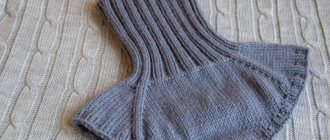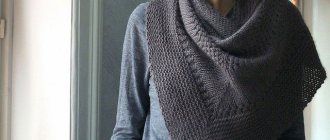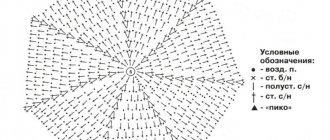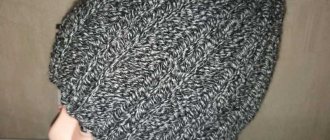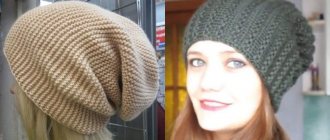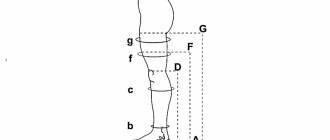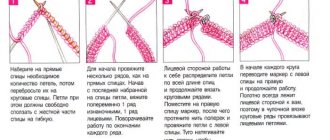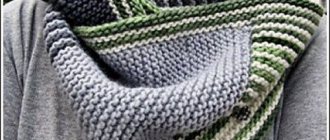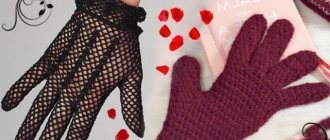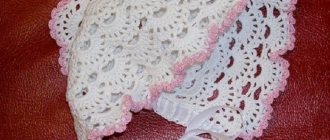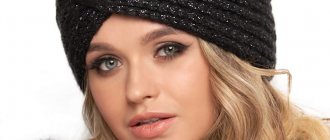After birth, each child’s body is not yet able to independently maintain a constant body temperature, being exposed to the danger of hypothermia, which is why it is so important to choose or create suitable clothes for him with your own hands.
Despite the countless number of children's stores and children's goods hypermarkets that sell literally everything, hand knitting of children's clothes remains popular today. When creating them, the soul, love and warmth of a mother's hands are invested. To knit a hat for a newborn with knitting needles, you need to know some nuances and, of course, have diagrams and descriptions on hand.
Useful tips: important for beginners
Before knitting a baby hat for your boy or girl up to a year old or older, beginning craftswomen need to take into account some nuances regarding the choice of yarn and other aspects.
Yarn selection
Depending on the time of year and ambient temperature, you need to choose the right yarn. It’s better to pick it up personally, since in this case you can touch it with your hands.
The yarn should be natural and soft, without irritating effect. In a warm room or outdoors, soft mercerized cotton, silk, soft linen, viscose or mixed options (cotton+linen, silk+viscose, cotton+silk, cotton+viscose) are suitable for hats. Cotton and linen should not “crunch” to the touch.
Artificial yarn specially created for such purposes is also suitable - tactifil and microfiber, they are even softer than natural ones. For cold weather, you need to choose wool. In this case, it is worth choosing well-processed alpaca or other soft yarn with a high wool content. It may not be 100% wool, but for the warming effect you need at least 50%.
Today on sale you can find a huge variety of different textures of yarn, which have not only a decorative function, but also massage, heat insulation, due to the air in the funnels. Textured short grass, velor, terry, etc. are suitable. Of course, it is better to choose a more pastel color, or something fresh and juicy, but not too bright.
Style
Depending on the shape of the baby's head, you can choose a style. Any model is suitable for a round face. For elongated head shapes, hats with ties under the chin are better suited.
A baby indoors or outdoors at a temperature of +22° and above does not need to cover his ears at all. On the contrary, his auditory analyzer will develop better if his ears are open.
For walks in cool and cold conditions, ears should be covered. The thickness of the baby model should also correspond to the air temperature. At temperatures below 22°, a thicker option is needed.
In virtual spaces you can choose a huge number of different models of knitted hats for a newborn.
One universal piece of advice: hats should be without rough seams, especially at the back, so as not to irritate or damage the baby’s delicate scalp.
Size
In the delivery room, each newborn baby’s head circumference is measured with a measuring tape and the mother is informed of this size. During the first time after birth, the head grows by 2 centimeters per month. Based on this, you can calculate the number of loops in 10 centimeters by knitting a sample, or use a ready-made pattern for a specific size.
The depth of the model can also be measured with a centimeter tape, or you can use a ready-made table. In any case, you can add 1-2 centimeters in volume so that the baby is definitely comfortable.
Knitting density
The density should be kept to medium. This will allow you to knit an elastic, but not loose model. Based on the thickness of the purchased yarn and its nature, you need to select suitable knitting needles. The recommended knitting needle and hook sizes are written on the yarn label.
How many loops to cast on
To calculate the number of loops, you need to knit a 10#10 cm sample and count the number of loops in it horizontally. Based on the circumference of the baby’s head, you need to multiply the number of loops of 10 cm by the circumference of the head and divide by 10 - this is the number and cast plus 2 edge ones.
Preparing for knitting
To knit a winter hat for a newborn, the mother decides on the style and color. This makes it easier to choose the right yarn and all the necessary accessories.
Knitting needle selection
Baby refuses breast milk
Some people prefer to knit using a crochet hook. Here we will talk about the technique of working with knitting needles. An experienced craftswoman has a whole set of these devices in her arsenal. A novice knitter still has to understand the features of choosing tools:
- Most women prefer steel needles. They are durable, do not bend, and rarely break. The surface is perfectly polished, so the knitted fabric glides easily along the knitting needle. There is one minus - steel needles are too heavy for a beginning craftswoman.
- A lightweight option is plastic or bone knitting needles. They are more often used for knitting things from fluffy yarn. In this option, there are restrictions on the diameter - due to the ability of the material to bend during operation, such knitting needles are not made thin.
- Wooden ones are used by a few and only for working with thick yarn. These needles are good for learning knitting techniques. If the tool is handled incorrectly, burrs may appear that interfere with operation.
- The combination of lightness and strength is inherent in aluminum needles. But when it comes into contact with your hands, the material oxidizes and stains the products. Therefore, it is not suitable for working with light-colored things.
Note! The ideal choice is aluminum knitting needles with a special coating. They weigh little, are perfectly smooth and do not stain the knitted fabric.
Design features
Knitting needles differ not only in material. There are several types of devices. Their choice depends on the future product model:
- for straight knitting you will need 2 knitting needles with a rounded or other limiter at the end; their opposite edge is sharpened, but not so sharp that you could injure your finger; standard needle length is 30-40 cm;
- for knitting in the round, you need a set of 5 knitting needles 15-20 cm long, with both pointed ends; Mittens and socks are usually knitted on them, and sometimes necks are decorated, but the devices are also suitable for some models of hats;
- circular knitting needles are 2 small needles connected to each other by a fishing line, plastic cord or steel cable on which the main fabric is located.
Choosing knitting needles
The knitting needles differ in thickness. This parameter determines the number of needles (for example, No. 2 is 2 mm).
Important! Knitting needles should be 1.5-2 times thicker in diameter than the thread from which you plan to knit a hat or other product.
Thread selection
Wool, cotton and synthetic yarns are suitable for hand knitting. If you need to make a winter hat for a newborn, it is better to choose thick wool or take a thin one with 2 threads.
Rainbow balls
You should not make the shade of yarn the main criterion when purchasing. The color scheme is important when making children's things, but other characteristics should be a priority:
- Thread twist. Tightly twisted yarn is only suitable for crocheting. When working on knitting needles, the fabric will be stiff, and the pattern may become skewed. Such a defect cannot be eliminated even by steaming the product.
- Elasticity. Testing this parameter is easy - just stretch the thread with a little force. If it springs back and tends to regain its length, the yarn is of excellent quality. Things knitted from it will not be deformed during use.
Simple options for a newborn hat
Options for beginners:
- The hat is knitted in stockinette stitch very easily. The front side is knitted with knit stitches, the back side with purl stitches.
- Garter stitch - knit stitches in both knit and purl rows.
- Elastic band 1*1 or 2*2. Knit alternately with knit and purl stitches, one and two, respectively.
- Braids. They are knitted with knit stitches, after a certain number of rows a cross of stitches is made according to the pattern, removing the loops on an additional knitting needle before or after work.
Simple patterns for knitting hats for newborns:
How to calculate the amount of yarn
When can you give your child pea soup?
Usually, hats are knitted using finished products presented in books or on the Internet. In addition to the description of the patterns, the amount of yarn in grams is indicated there. This parameter is conditional, since each craftswoman has her own style - some knit tightly, others weakly.
Note! It is recommended to add an extra 50-100 g of yarn to the indicated weight. It is better to have a little thread left after finishing the work than to have a shortage during the process.
We knit a pattern for a boy
Hats for newborn boys are traditionally white, blue or green and have a laconic, openwork knit. Perhaps a “braid” pattern would be suitable, which is knitted with knit stitches and consists of an even number of loops.
Brief descriptions of how to knit hats for boys:
- A rectangular hat for a boy consists of two identical halves (front and back), they are connected on the left and right with seams.
- The round pattern is knitted in the form of a rectangle with a length equal to the circumference of the head, then the loops are decreased according to the pattern to form a round shape.
- Hat-helmet. It is knitted in the shape of a helmet with closed ears. There are a lot of drawings, you need to choose the most optimal one.
- A striped hat is knitted from yarn of several colors in stripes, with an even number of loops.
How to sew a fleece hat with elongated ears
This master class will show in detail the steps of sewing a fleece hat.
- Lengthen the “ears”, divide the patterns in half.
- The outer part is cut in separate parts, according to a template, and the lining is one-piece.
- Fold the triangles in pairs and sew one side. Then fold them together and sew the top edge with one line. The result is a hemisphere - the upper part of the headdress.
- Sew the back seam at the bottom part, connect it to the hemisphere - the outer half is ready.
- It is easier to assemble the lining, since it is one-piece - sew the triangles and the back seam with a machine stitch.
- Place the outer and inner parts facing each other and sew, leaving an opening for turning inside out.
- Turn the product inside out, stitch along the bottom edge, and sew on Velcro.
Knitting for girls
This option is perfect for discharge from the hospital:
Traditionally, hats for girls are knitted in red, pink, lilac colors and decorated with flowers and ruffles. But there may be a lot of other options, depending on the taste and level of creativity of the mother. Options for a knitted hat for a girl:
- Openwork, lace models and caps are incredibly beautiful! They look very impressive and airy, but are only suitable for warm weather.
- All kinds of flower applications.
- Hat with ears in the shape of a cat or bunny.
Here is the openwork knitting pattern:
Winter hat for newborn
To protect a newborn baby from winter frosts, you need a very warm, thick hat made of wool, possibly double. Hypothermia is extremely dangerous for a newborn baby, so a winter hat should be as thick as possible. Some universal requirements for a warm winter hat for a newborn:
- The yarn for the hat should be wool or mixed yarn with a high wool content. It can be alpaca or merino, although other wool, mohair and even goat down will also work.
- The knitting density should be medium or high. It is individual, calculated by creating a 10 by 10 cm sample. The number of horizontal and vertical loops in this limited area will be the knitting density.
- The hat should be knitted with some kind of voluminous, but not openwork pattern.
- The ideal winter hat tightly covers the ears completely. To do this, it is better to choose a model with ties under the chin. But they should not be made from 100% wool, as it can irritate and chafe the skin under the chin.
- The inside should not be prickly or irritating, and should not have hard seams.
Product modeling
Before starting work, you must choose a cap model. A cap pattern is searched on the Internet, magazines or master classes. If imagination works well, then it is better to rely on it and make an original headdress. It can be sewn or knitted, and you can add ears or ribbons to it. You can sew a hat for a newborn with your own hands in several stages, which are presented below.
Winter plush option
How to knit different models of hats for newborns
With ties
Description of knitting a hat with ties for a newborn:
- Take 50 grams of half-wool, wool or cotton yarn and knitting needles N3. You need to cast on the number of loops based on the knitting density of 28 loops in 10 centimeters horizontally and the actual girth of the head. First, an elastic band is knitted, alternating purl and knit stitches with a height of 6-8 rows. Next - knitting according to the pattern.
- The resulting canvas is divided into 6 parts. Each row cast on with knit stitches is shortened by 6 stitches - one in each part.
- We leave 3 loops on each side to form ties of the required length, but first tie the remaining 6 loops.
The video shows a method of knitting ties for a baby hat:
With ears
These are the cutest hats for creating unforgettable photos and videos for your family album. Bears, frogs, owls, hares, etc. They are knitted with decreasing stitches on both sides, forming an oval or circle.
Or the hat is knitted with ears for insulation. There are a lot of different models. The photo shows several patterns and descriptions of knitting an owlet hat:
How else can you knit a cool hat with ears for newborn babies:
With a toe
Another option is a hat with a toe. This is a classic hat model, universal for boys and girls. It is easier and simpler to knit such a hat crosswise, that is, vertically in garter stitch.
You need to make a pattern according to the size of the baby’s head, and following it, simply increase and decrease loops in each row, making the fabric zigzag, as in the photo below.
Master class on another model of a hat with a toe for a baby:
Elf cap
The Elf hat is a style that emphasizes the fragility and cuteness of the baby. It can be knitted for a baby 6 months and older.
Wool blend yarn with a thread thickness of 220m/100g 50 - 60 grams is suitable. Knitted on four needles No. 4.5 in circular rows in stockinette stitch (all stitches are knit).
Description of knitting pattern Elf:
- You need to cast on 60 stitches on the knitting needles, distributing them into 15 stitches on each knitting needle. If you wish, you can start with an elastic band of 6-8 rows 1*1, that is, 1 knit stitch, 1 purl loop.
- 24 rows are knitted in stockinette stitch: in the front row all stitches are knit, in the purl row - purl.
- Then, on each knitting needle in the next 4 rows, cut 1 loop, knitting 2 together.
- When there are 5 loops left on each knitting needle, you need to stop decreasing and simply knit another 20 rows evenly, covering them with a working thread. This will be the knot.
Master class on video:
Cap
Description of knitting a cap in the video:
A bonnet is not a very fashionable and popular style today; it is easier to crochet it. But there are lovers and connoisseurs of such classic knitting patterns for newborn babies.
These hats are knitted by creating a horizontal rectangle and joining it with a spherical back. The front corners of the rectangle are continued with ribbon ties.
Knitting pattern for a cap step by step:
With pom-poms
A hat with pompoms looks no less cute. This way you can decorate any hat.
Option for knitting a hat for a newborn:
Instructions
Each work begins with a set of loops and ends with their closing. For inexperienced knitters, these moments are sometimes difficult.
Start of casting on loops
There are 12 ways to complete a zero row. Each of them starts with a cast-on loop. One of the options for creating a starting row is shown in Fig. below.
Loop set diagram
The thread coming from the ball is placed over the thumb and index finger of the left hand, while the knitting needle is in the right. To ensure sufficient tension, hold the thread with the remaining three fingers.
Closing the loops
Completing the knitting of any fabric is also done in several ways. The most common fastening options:
- sequentially knitting 2 loops together (1st and subsequent ones);
- by pulling one loop through another;
- grabbing and pulling the working thread with a hook.
There are several more variations of the kettel stitch, when the loops are secured with a needle. But these techniques for beginning craftswomen are more complicated than those mentioned above.
